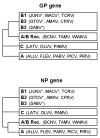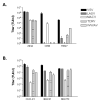Receptor use by the Whitewater Arroyo virus glycoprotein
- PMID: 17997467
- PMCID: PMC2270610
- DOI: 10.1016/j.virol.2007.10.004
Receptor use by the Whitewater Arroyo virus glycoprotein
Abstract
Whitewater Arroyo virus (WWAV) is a North American New World arenavirus, first isolated from rats in New Mexico in 1993, and tentatively associated with three human fatalities in California in 1999-2000. However, it remains unclear whether WWAV was the cause of these, or any other, human infections. One important characteristic of viruses that influences pathogenic potential is the choice of cellular receptor and the corresponding tropism of the virus. In the arenaviruses, these properties are determined largely by the viral glycoprotein (GP). We have previously noted for the New World clade B arenaviruses, which include four severe human pathogens, that the ability to cause human disease correlates with the ability of the GP to use the human transferrin receptor 1 (hTfR1) to enter cells. In addition, pseudotyped retroviral vectors displaying the GPs from pathogenic clade B viruses transduced a range of cell lines in vitro that were distinct from those that could be transduced by non-pathogenic clade B viruses. WWAV was initially classified as a New World clade A virus, based on sequence analysis of its nucleoprotein gene. However, more extensive analyses have revealed that WWAV and the other North American arenaviruses are probably recombinant clade A/B viruses, and that the WWAV GP is more closely related to the clade B GPs. Based on this finding, we sought to understand more about the possible pathogenic potential of WWAV by determining whether its clade B-like GP exhibited the characteristics of a pathogenic or non-pathogenic clade B virus. Our studies found that WWAV GP did not use hTfR1 for entry, and that its overall in vitro tropism was most similar to the GPs from the non-pathogenic clade B viruses. Although many viral factors in addition to GP receptor use and tropism determine whether a virus is able to cause disease in humans, our analysis of the WWAV GP does not support the idea that WWAV is a human pathogen.
Figures







Similar articles
-
Human and host species transferrin receptor 1 use by North American arenaviruses.J Virol. 2014 Aug;88(16):9418-28. doi: 10.1128/JVI.01112-14. Epub 2014 Jun 11. J Virol. 2014. PMID: 24920811 Free PMC article.
-
Differences in tropism and pH dependence for glycoproteins from the Clade B1 arenaviruses: implications for receptor usage and pathogenicity.Virology. 2007 Jul 20;364(1):132-9. doi: 10.1016/j.virol.2007.03.003. Epub 2007 Mar 29. Virology. 2007. PMID: 17397892 Free PMC article.
-
Host-species transferrin receptor 1 orthologs are cellular receptors for nonpathogenic new world clade B arenaviruses.PLoS Pathog. 2009 Apr;5(4):e1000358. doi: 10.1371/journal.ppat.1000358. Epub 2009 Apr 3. PLoS Pathog. 2009. PMID: 19343214 Free PMC article.
-
Cell entry by human pathogenic arenaviruses.Cell Microbiol. 2008 Apr;10(4):828-35. doi: 10.1111/j.1462-5822.2007.01113.x. Epub 2007 Dec 21. Cell Microbiol. 2008. PMID: 18182084 Review.
-
New World Arenavirus Biology.Annu Rev Virol. 2017 Sep 29;4(1):141-158. doi: 10.1146/annurev-virology-101416-042001. Epub 2017 Jun 23. Annu Rev Virol. 2017. PMID: 28645238 Free PMC article. Review.
Cited by
-
Rational design of universal immunotherapy for TfR1-tropic arenaviruses.Nat Commun. 2020 Jan 3;11(1):67. doi: 10.1038/s41467-019-13924-6. Nat Commun. 2020. PMID: 31900422 Free PMC article.
-
Hemorrhagic Fever-Causing Arenaviruses: Lethal Pathogens and Potent Immune Suppressors.Front Immunol. 2019 Mar 13;10:372. doi: 10.3389/fimmu.2019.00372. eCollection 2019. Front Immunol. 2019. PMID: 30918506 Free PMC article. Review.
-
Identification of a broad-spectrum arenavirus entry inhibitor.J Virol. 2008 Nov;82(21):10768-75. doi: 10.1128/JVI.00941-08. Epub 2008 Aug 20. J Virol. 2008. PMID: 18715909 Free PMC article.
-
Nonhuman transferrin receptor 1 is an efficient cell entry receptor for Ocozocoautla de Espinosa virus.J Virol. 2013 Dec;87(24):13930-5. doi: 10.1128/JVI.02701-13. Epub 2013 Oct 9. J Virol. 2013. PMID: 24109228 Free PMC article.
-
New world clade B arenaviruses can use transferrin receptor 1 (TfR1)-dependent and -independent entry pathways, and glycoproteins from human pathogenic strains are associated with the use of TfR1.J Virol. 2008 Jan;82(2):938-48. doi: 10.1128/JVI.01397-07. Epub 2007 Nov 14. J Virol. 2008. PMID: 18003730 Free PMC article.
References
-
- Bennett SG, Milazzo ML, Webb JP, Jr, Fulhorst CF. Arenavirus antibody in rodents indigenous to coastal southern California. Am. J. Trop. Med. Hyg. 2000;62:626–30. - PubMed
-
- Bonthius DJ, Wright R, Tseng B, Barton L, Marco E, Karacay B, Larsen PD. Congenital lymphocytic choriomeningitis virus infection: Spectrum of disease. Ann. Neurol. 2007 Epub ahead of print. - PubMed
-
- Bowen MD, Peters CJ, Nichol ST. The phylogeny of New World (Tacaribe complex) arenaviruses. Virology. 1996;219:285–290. - PubMed
-
- Bowen MD, Peters CJ, Nichol ST. Phylogenetic analysis of the Arenaviridae: patterns of virus evolution and evidence for cospeciation between arenaviruses and their rodent hosts. Mol. Phylogenet. Evol. 1997;8:301–16. - PubMed
Publication types
MeSH terms
Substances
Grants and funding
LinkOut - more resources
Full Text Sources

